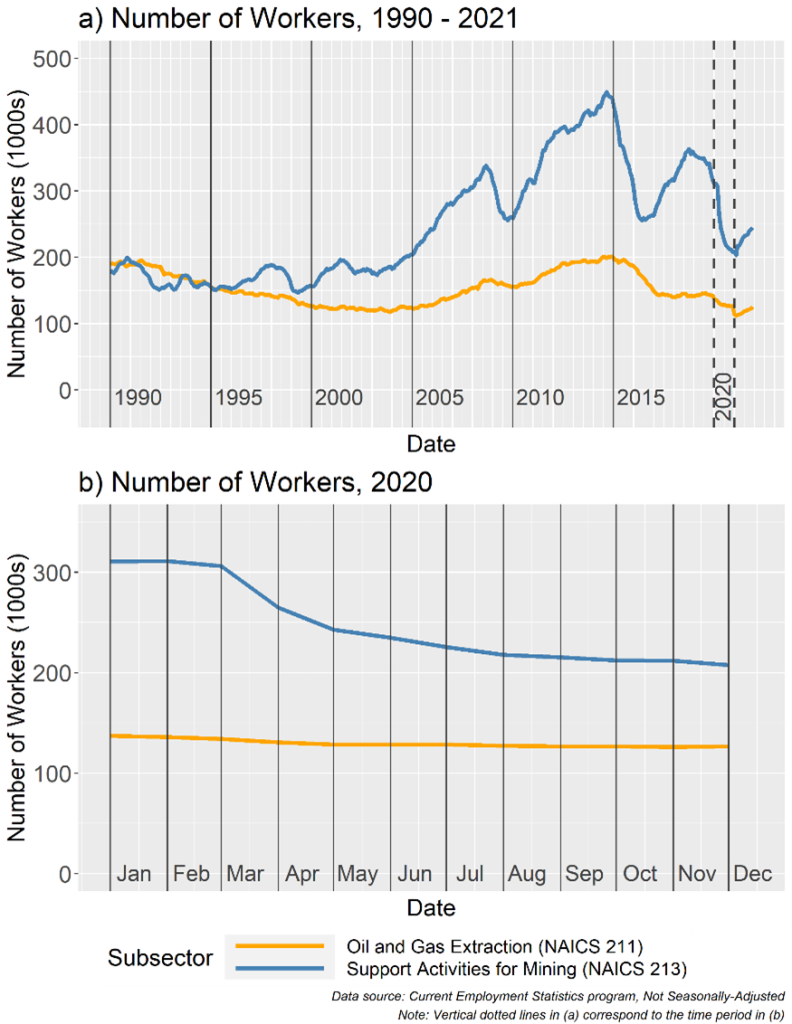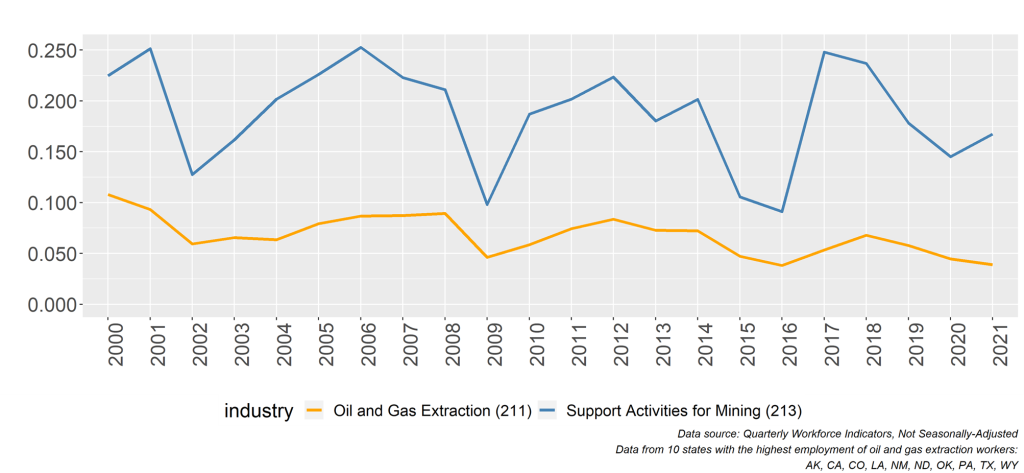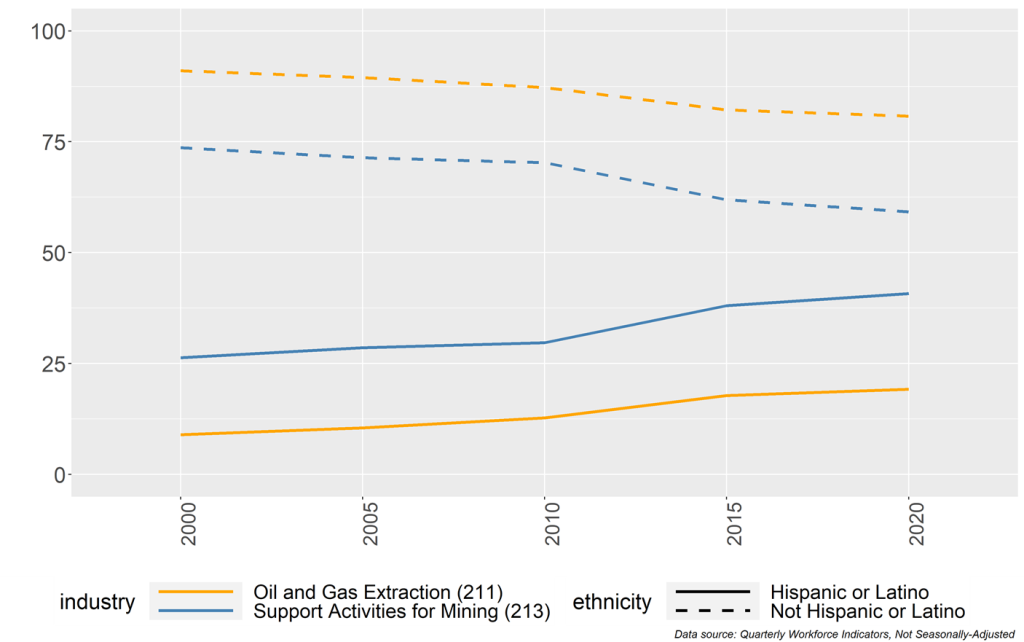Oil and Gas Workers Count
Posted on by
Energy has been in the news lately. Amid the discussions about energy prices and climate change, there has been far less media attention on the people who do hazardous work extracting the oil and gas so many of us use to stay warm and get where we need to go. These workers and the companies they work for are part of a global energy market that changes quickly. At the most recent meeting of the National Occupational Research Agenda (NORA) Oil and Gas Extraction Sector Council, health and safety professionals shared how industry-wide labor force trends were impacting their work. This blog provides a broad overview of recent trends in the ups and downs of employment among U.S. oil and gas extraction (OGE) companies, as well as some of the implications for worker health and safety.
How Have Oil and Gas Workers Fared Recently?
Official U.S. employment statistics are maintained in a number of places, including a website managed by the St. Louis Federal Reserve Bank. This data can be used to see how the recent fluctuations in global energy markets have affected the number of people working in the U.S. OGE industry. Data downloaded from the website, originally from the Current Employment Statistics program and limited to the years 2009-2021, were used to create the figure below. The figure shows what “booms” and “busts” can look like over time.
Figure 1: The Number of Workers Employed in the Oil and Gas Extraction Industry by Month, Year, and North American Industrial Classification System (NAICS) Subsector

Each line represents employees of oil and gas extraction companies. So, why are there two of them?
Federal codes split the OGE workforce into two groups. One group, in orange, consists of workers employed by oil and gas operators – companies that maintain leases to drill and extract fossil fuel. The other group, in blue, represents workers employed by contractors – companies hired by oil and gas operators to carry out particular activities. The official title of the second group, “Support activities for mining,” could be misleading since almost all of these workers are employed in OGE. Employees of OGE contractors are hidden, in a way, by the misnomer.
Both the operator and contractor workforces are important to count. Contractors employ many more workers than operators. The data in the figure also show the contractor workforce fluctuates more than the operator workforce when market demands shift. Figure 1b uses 2020 – a year when oil and gas employment plummeted – as an example. The number of OGE workers employed by operators dropped from 137,200 in January to 126,200 in December, a difference of 11,000 workers or an 8% decline. During the same period, employment among contractors dropped from 311,400 to 207,800, a difference of 103,600 workers – a decline of 33%.
The differences between employees of OGE contractors and employees of operators do not end there.
Industrial Codes Have Meaning for Safety and Health
Through its Oil and Gas Extraction Program, the National Institute for Occupational Safety and Health (NIOSH) conducts research, works with partners, and develops and communicates workplace solutions to improve worker safety and health in the oil and gas extraction industry. Since 2008, NIOSH researchers have documented differences between the health and safety experiences of operators and contractors. Compared to employees of OGE operators, employees of OGE contractors have higher rates of fatal motor vehicle crashes,1 fatal falls at work,2 and total workplace fatalities.3 Contractor employees have reported longer shifts, longer average commutes,4 and higher levels of exposure to various chemicals than operator employees.5
Health and safety differences have also been found between different types of contractors and phases of operation. For example, OGE workers’ exposures to diesel particulate matter tend to be higher during well completions and drilling operations than during well servicing operations, all tasks that may be carried out by different types of contractors.6 Rates of fatal occupational injuries3 and fatal fall injuries2 were found to be higher among drilling contractor employees, compared to servicing company employees.
In addition to differences in the types of work they do and the workplace hazards associated with those activities, OGE operators and contractors tend to employ different workers, on average.
New Workers
Since the depths of 2020, hiring has begun again in the oil and gas industry. At the Sector Council meeting, NIOSH researchers learned from industry partners that with the increased demand for oil and gas production it has been very difficult to recruit and retain workers. They cited multiple reasons, including the competitive labor market overall and new employees with little-to-no prior experience being poorly prepared for jobs in the oil fields. In times like these, when companies are struggling to fill spots, new workers comprise a larger and larger share of the OGE workforce. Here, too, operators and contractors differ. Figure 2 shows how the overall share of OGE workers who are new has changed over time and how these changes have been different for operators and contractors.
Figure 2: The Proportion of Workers Employed in the Oil and Gas Extraction Industry Who Were Hired within the Past Year, by Month, Year, and North American Industrial Classification System (NAICS) Subsector; 2000-2021

In 2017, nearly 25% of contractor employees had been employed for one year or less, compared to 5% of operator employees.
Members of the Sector Council expressed concern about the pace of new hires in the industry, due in large part to injury risks associated with being in a new and hazardous environment. Some companies, who recognize new workers are at higher risk of injury, are working to innovate new training methods and retention strategies to better protect workers. Evaluations of those interventions – to see which are effective and which aren’t – are sorely needed, especially among oil and gas contractors who drill, complete, or service wells.
Workers with Hispanic or Latino Ethnicity
NIOSH’s Future of Work Initiative calls attention to demographic changes in the U.S. workforce. The OGE workforce has been changing, too. Data from Texas, a state that employs more than 50% of all U.S. OGE workers, are presented in Figure 3.
Figure 3: Proportion of Oil and Gas Extraction Workers Who Were Hired within the Past Year, by Hispanic or Latino Ethnicity, Month, Year, and North American Industrial Classification System (NAICS) Subsector; 2000-2021

The proportion of OGE workers in Texas who have Hispanic or Latino ethnicity has increased since 2000. This is true for both operator employees and contractor employees. Also, the proportion of OGE workers who have Hispanic or Latino ethnicity is consistently higher among OGE contractors than OGE operators. Combined with the NIOSH research mentioned earlier, that found higher occupational health and safety risks among contractor employees,1-5 the data in Figure 3 suggest Hispanic or Latino workers in OGE may face disproportionately greater health and safety risks at work than workers who are not Hispanic or Latino. A recent NIOSH study, which included a convenience sample with 36% Hispanic or Latino workers, found some evidence of differences in self-reported occupational exposures by race and ethnicity.5 There is a need for additional research exploring occupational health inequities among Hispanic or Latino OGE workers.
Every peer-reviewed study, website, table, and graph relying on federal data is likely to reflect the fragmentation between contractors and operators, shaping the public’s understanding of the OGE workforce. If an analyst or researcher is unaware OGE contractors are classified with a different industry code than operators, the analysis may be biased or limited in its generalizability. Industry coding may seem like a tedious bureaucratic detail, but the evidence summarized in this blog indicates that codes also coincide with meaningful differences in the industry – differences that are related to safety and health outcomes, and workers who may experience disproportionate risks. Researchers can, therefore, use the codes to better understand how operators’ and contractors’ safety and health experiences can be influenced by ups and downs in the market.
As the OGE workforce continues to evolve, NIOSH researchers will be keeping tabs on employment, health, and safety trends by engaging industry partners through the Sector Council, conducting responsive research, and doing what we can to ensure the people who do the work of keeping us warm can lead safe and healthy working lives. In the meantime, do you have any stories you can share about how the ups and downs of the OGE industry have impacted worker health and safety? Did you ever work for a company in OGE, or another “boom and bust” industry, that went above and beyond to protect the health, safety, and well-being of their workforce during times of change? If so, please share in the comments below.
Ken Scott, PhD, MPH, is an Epidemiologist in the NIOSH Western States Division.
Tim Bushnell, PhD, MPA, is an Economist in the NIOSH Economic Research and Support Office.
References
- Retzer KD, Hill RD, Pratt SG. Motor vehicle fatalities among oil and gas extraction workers. Accid Anal Prev. Mar 2013;51:168-74. doi:10.1016/j.aap.2012.11.005
- Mason KL, Retzer KD, Hill R, Lincoln JM. Occupational Fatalities Resulting from Falls in the Oil and Gas Extraction Industry, United States, 2005-2014. MMWR Morb Mortal Wkly Rep. Apr 28 2017;66(16):417-421. doi:10.15585/mmwr.mm6616a2
- Mason KL, Retzer KD, Hill R, Lincoln JM. Occupational fatalities during the oil and gas boom–United States, 2003-2013. MMWR Morb Mortal Wkly Rep. May 29 2015;64(20):551-4.
- Hagan-Haynes K, Ramirez-Cardenas A, Wingate KC, et al. On the road again: A cross-sectional survey examining work schedules, commuting time, and driving-related outcomes among U.S. oil and gas extraction workers. Am J Ind Med. Jun 23 2022;doi:10.1002/ajim.23405
- Wingate KC, Scott KA, Pratt S, et al. Self-reported exposure to hazards and mitigation strategies among oil and gas extraction workers in three U.S. states. J Occup Environ Hyg. Oct 7 2022:1-14. doi:10.1080/15459624.2022.2123496
- Esswein EJ, Alexander-Scott M, Snawder J, Breitenstein M. Measurement of area and personal breathing zone concentrations of diesel particulate matter (DPM) during oil and gas extraction operations, including hydraulic fracturing. J Occup Environ Hyg. Jan 2018;15(1):63-70. doi:10.1080/15459624.2017.1388512
Posted on by

